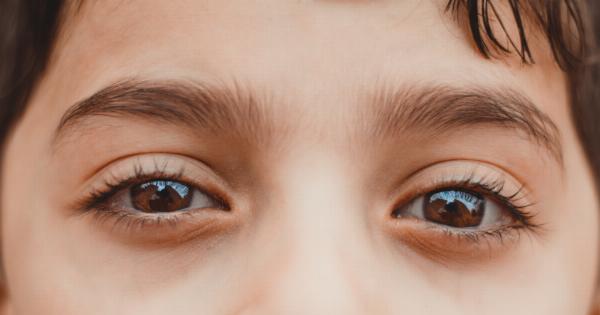Eye discharge, also known as “rheum,” is a common condition that affects people of all ages. It refers to the discharge that can accumulate in the corners of the eyes or along the eyelashes.
While eye discharge is usually harmless and easy to manage, it can sometimes indicate an underlying medical condition. In this article, we will explore the various causes of eye discharge and discuss when it may be necessary to seek medical attention.
Understanding Eye Discharge
Eye discharge is a natural function of our eyes. It helps to keep the eyes lubricated and protect them from irritants. Tears, mucus, and oil glands in the eyelids work together to produce this discharge, which is typically clear and thin.
However, if you notice a change in the consistency, color, or amount of eye discharge, it may be a sign of an underlying problem. Abnormal eye discharge can manifest in various ways, including:.
Types of Eye Discharge
1. Watery Discharge:.
Watery discharge is usually clear and thin. It can occur due to environmental factors such as allergies, dry air, or exposure to irritants like smoke or dust.
In most cases, watery discharge is not a cause for concern, and it typically resolves on its own.
2. Sticky or Stringy Discharge:.
Sticky or stringy discharge can indicate the presence of an infection. This type of discharge often has a thicker consistency and can make it difficult to open the eyes, especially after waking up in the morning.
Sticky or stringy discharge may be a symptom of conjunctivitis, commonly known as pink eye.
3. Mucus-like Discharge:.
If you notice a thick, yellowish or greenish discharge, it could be a sign of an infection. Mucus-like discharge is commonly associated with bacterial or viral conjunctivitis. It may also be accompanied by redness, itching, and discomfort.
4. Crusty Discharge:.
Crusty discharge forms when eye discharge dries and hardens overnight. It can make the eyelids stick together, causing difficulty in opening the eyes.
Crusty discharge is often seen in cases of bacterial or viral conjunctivitis, a stye, or blepharitis (inflammation of the eyelids).
Common Causes of Eye Discharge
Several factors can contribute to eye discharge. Here are some of the most common causes:.
1. Allergies
Allergies can trigger eye discharge, particularly watery discharge. When your eyes come in contact with allergens like pollen, pet dander, or dust mites, they may produce excessive tears as a protective mechanism.
2. Conjunctivitis
Conjunctivitis, also known as pink eye, is an inflammation of the conjunctiva – the thin, transparent layer covering the whites of the eyes. This condition can be caused by bacteria, viruses, allergies, or irritants.
Conjunctivitis often leads to different types of eye discharge, depending on the cause.
3. Eye Infections
Eye infections, such as bacterial or viral infections, can cause abnormal eye discharge. These infections may occur due to poor hygiene, sharing contaminated items, or inadequate contact lens care.
4. Blocked Tear Ducts
A blocked tear duct can prevent tears from draining adequately, resulting in excessive eye discharge. This condition is particularly common in infants and may require medical intervention if it persists.
5. Blepharitis
Blepharitis refers to the inflammation of the eyelids, usually caused by bacterial overgrowth along the lash line or oil glands. This condition can lead to crusty discharge or the sensation of having something in the eye.
6. Dry Eyes
Insufficient tear production or poor tear quality can cause the eyes to become dry and irritated. As a result, the eyes may produce excessive discharge to compensate for the lack of moisture.
When to Seek Medical Attention
In most cases, eye discharge is not a cause for concern and can be managed with self-care measures. However, it is important to consult a healthcare professional if:.
1. The discharge is accompanied by severe pain, sensitivity to light, or changes in vision.
These symptoms may indicate a more severe underlying condition that requires immediate medical attention.
2. The discharge is accompanied by other signs of infection, such as redness, swelling, or fever.
These symptoms can suggest a bacterial or viral infection that may require medical treatment.
3. The discharge persists or worsens over time despite self-care measures.
If your eye discharge does not improve or becomes chronic, it is advisable to consult an eye care professional to determine the underlying cause.
Self-Care Measures for Managing Eye Discharge
While medical intervention may be necessary in some cases, there are several self-care measures you can take to manage mild cases of eye discharge:.
1. Practice good hygiene.
Wash your hands frequently and avoid touching or rubbing your eyes, as this can introduce bacteria and irritants.
2. Use warm compresses.
Applying a warm compress to your eyes can help loosen any crusty discharge and soothe inflammation. Use a clean cloth soaked in warm water and gently place it over your closed eyelids for a few minutes.
3. Clean your eyelids.
If you have crusty discharge, gently clean your eyelids using a mild, tear-free cleanser or baby shampoo diluted with warm water. Use a cotton pad to remove any debris along the lash line.
4. Avoid wearing contact lenses.
If you wear contact lenses and experience eye discharge, switch to wearing glasses until the discharge clears. Contact lens wear can exacerbate eye irritation and prolong the healing process.
5. Use artificial tears.
If you have dry eyes, using over-the-counter artificial tears can help lubricate your eyes and reduce the production of excessive discharge. Consult your eye care professional to determine the most suitable type of artificial tears for your condition.
Conclusion
Eye discharge is a common occurrence that usually poses no significant threat to eye health. However, if the discharge is accompanied by other symptoms or persistent discomfort, it is important to seek medical attention.
By understanding the different types of eye discharge and their potential causes, you can better manage and maintain your eye health.





























